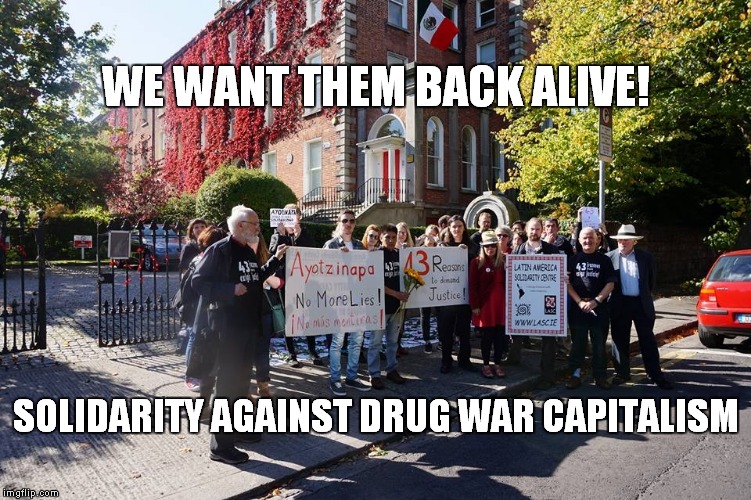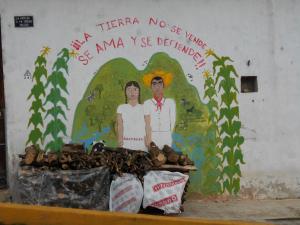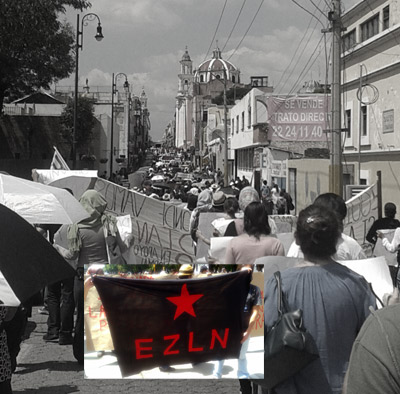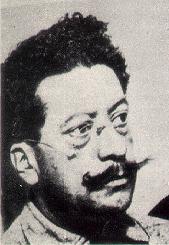Over 30 years of anarchist writing from Ireland listed under hundreds of topics
Mexico
Solidarity against the Terrorist Narco-State of Mexico from Dublin, Ireland
Police murder of anarchist Salvador Oleos Garcia
 The province of Oaxaca in Mexico has seen a massive revolt led by the teachers union in recent weeks. In the course of the repression of the protests police have already killed 12 people, overnight we have heard that they have killed another, the anarchist Salvador Oleos Garcia.
The province of Oaxaca in Mexico has seen a massive revolt led by the teachers union in recent weeks. In the course of the repression of the protests police have already killed 12 people, overnight we have heard that they have killed another, the anarchist Salvador Oleos Garcia.
He has been described as journalist, community activist, defender of the lands, singer and pioneer of the anarcho-punk movement in Huajuapan. Reports indicate that after a police tip off he was found at the road side with injuries to the limbs, head and torso, he later died in hospital.
“We want them back alive!” Dublin Solidarity with the Disappeared of Ayotzinapa, Mexico
 Can you imagine the state using its police force in order to create opportunities for capitalists to make money? Can you imagine natural resources not being used for the benefit of an ecologically sustainable society and instead being used purely for corporations' profit?
Can you imagine the state using its police force in order to create opportunities for capitalists to make money? Can you imagine natural resources not being used for the benefit of an ecologically sustainable society and instead being used purely for corporations' profit?Hope, Friendship and Surprise in the Zombie Time of Capitalism: An interview with Gustavo Esteva
Gustavo Esteva is an independent writer and grassroots activist. He has been a central contributor to a wide range of Mexican, Latin American, and international nongovernmental organizations and solidarity networks, including the Universidad de la Tierra en Oaxaca and the Zapatista Army of National Liberation. The WSM's Tom Murray caught up with Gustavo at a recent public lecture at the Kimmage Development Centre to discuss hope, friendship and surprise in the zombie-time of capitalism, and how people are taking initiatives, reclaiming control of their lives and creating vibrant, autonomous alternatives here today.
Projects of Death in Mexico’s Sierra Norte - Community and Environment Under Attack
 OLINTLA is a small village in the Sierra Norte, a remote, mountainous region to the east of Mexico City. The landscape there is dramatic, green and beautiful, mostly sunlit jungle, rivers and wildlife. The hillsides are occasionally populated by farming towns and villages, mainly indigenous communities whose way of life is constantly threatened. In recent years, the Mexican state has accelerated plans for the development of a vast hydroelectric power plant in the area, directly impacting the people in Olintla and about a dozen or so neighbouring communities. What appears on the surface to be a ‘green energy’ project is in fact closely bound up with community displacement and the aggressive extraction of local oil and gas reserves, primarily to the detriment of the region’s water resources and wider capacity to sustain life. Unfortunately, Olintla is far from an atypical case but represents how indigenous communities in Mexico, as in Latin America more generally, tend to bear the brunt of the state’s creation of opportunities for private capital accumulation, called ‘development’ by those in power and ‘projects of death’ by the communities affected.[1]
OLINTLA is a small village in the Sierra Norte, a remote, mountainous region to the east of Mexico City. The landscape there is dramatic, green and beautiful, mostly sunlit jungle, rivers and wildlife. The hillsides are occasionally populated by farming towns and villages, mainly indigenous communities whose way of life is constantly threatened. In recent years, the Mexican state has accelerated plans for the development of a vast hydroelectric power plant in the area, directly impacting the people in Olintla and about a dozen or so neighbouring communities. What appears on the surface to be a ‘green energy’ project is in fact closely bound up with community displacement and the aggressive extraction of local oil and gas reserves, primarily to the detriment of the region’s water resources and wider capacity to sustain life. Unfortunately, Olintla is far from an atypical case but represents how indigenous communities in Mexico, as in Latin America more generally, tend to bear the brunt of the state’s creation of opportunities for private capital accumulation, called ‘development’ by those in power and ‘projects of death’ by the communities affected.[1]
Organize your Rage! Popular Outrage shakes Mexico at Student Disappearances in Guerrero
 Protests took place in cities across Mexico yesterday following the disappearance of 43 student teachers in the southern state of Guerrero almost two weeks ago, with many of those having gone missing after the police arrested them. Thousands of people blocked streets and roads, chanting “They took them alive; we want them back alive"!
Protests took place in cities across Mexico yesterday following the disappearance of 43 student teachers in the southern state of Guerrero almost two weeks ago, with many of those having gone missing after the police arrested them. Thousands of people blocked streets and roads, chanting “They took them alive; we want them back alive"!
The students, who studied at Ayotzinapa, a radical teacher training college in Guerrero, went missing on the night of 26 September. Iguala’s municipal police fired on the students’ buses and, an hour later, unidentified gunmen fired upon them again. The attacks left three students and three others dead in the city, as well as at least 17 wounded. 43 students remain unaccounted for, a significant number of whom were seen being driven away in police vehicles after the first attack. A mass grave has since been found in a nearby location, but the charred remains have yet to be identified.
State repression in Mexico against anarchists and social movements
 Following an 11 hour riot sparked by a brutal police attack on demonstrations against the inauguration of the new president in Mexico City on 1 December, the local government declares a witch hunt against anarchists. Through declarations made by the head of the Government of the Federal District (Mexico City is constitutionally incorporated as a Federal District, following the US model) blame for the bloody events has been directed at Mexican anarchists. Over 50 anarchists remain in prison and face being charged with terrorist legislation and scapegoated for what was a public outpouring of fury at intolerable economic deprivation, official corruption and police brutality. WSM is reprinting below the statement from the Mexican Anarchist Black Cross in response to the accusations of anarchists being the instigators and "ring-leaders" of the events of 1st December, to spread awareness of the current repression in Mexico.
Following an 11 hour riot sparked by a brutal police attack on demonstrations against the inauguration of the new president in Mexico City on 1 December, the local government declares a witch hunt against anarchists. Through declarations made by the head of the Government of the Federal District (Mexico City is constitutionally incorporated as a Federal District, following the US model) blame for the bloody events has been directed at Mexican anarchists. Over 50 anarchists remain in prison and face being charged with terrorist legislation and scapegoated for what was a public outpouring of fury at intolerable economic deprivation, official corruption and police brutality. WSM is reprinting below the statement from the Mexican Anarchist Black Cross in response to the accusations of anarchists being the instigators and "ring-leaders" of the events of 1st December, to spread awareness of the current repression in Mexico.
3,000 police evict Mexican students after nine month UNAM occupation
SUNDAY, FEBRUARY 6TH: Students from the National Autonomous University of Mexico, the largest and historically the most prestigious university in Latin America, were engaged in debate over the slim chances of achieving effective negotiation with the University Council. This was to enable classes to restart after a lengthy strike which had seen the occupation of all the university buildings, the erection of barricades around the campuses and monster marches through the streets of Mexico City.
The Zapatistas and direct democracy
On January 1st 1994, a rebel army called the Emiliano Zapata Liberation Front (EZLN) rose against the Mexican government in Chiapas, Mexico. Workers Solidarity contributor Andrew Flood has been researching the life of ordinary people in the Zapatista area. Below he writes about some of his findings
Biography of Mexican anarchist Ricardo Magon
 INSIDE MODERN MEXICO the name of Ricardo Flores Magon is well known, and is regarded in a somewhat similar way to that of James Connolly in Ireland. But outside Mexico few have heard of him. Born to a poor family in 1873, he became a journalist on the opposition paper 'El Demócrata' after finishing school. In 1900, along with his brother Jesús, he founded "Regeneración', a radical paper opposed to the dictatorship of Porfirio Diaz.
INSIDE MODERN MEXICO the name of Ricardo Flores Magon is well known, and is regarded in a somewhat similar way to that of James Connolly in Ireland. But outside Mexico few have heard of him. Born to a poor family in 1873, he became a journalist on the opposition paper 'El Demócrata' after finishing school. In 1900, along with his brother Jesús, he founded "Regeneración', a radical paper opposed to the dictatorship of Porfirio Diaz.

